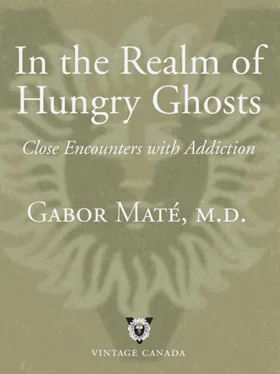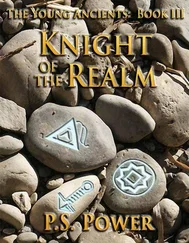
The dominant emotions suffusing all addictive behaviour are fear and resentment—an inseparable vaudeville team of unhappiness. One prompts and sets up the other: fear of the way things are and resentment that they are that way; fear of life and resentment that life is as difficult as it is; fear of unpleasant mind-states and resentment that unpleasant moods and thoughts persist; fear that we’ll never feel all right and resentment that we cannot feel the way we want to; fear of the present and the future and resentment that we cannot control destiny. “Addiction is running from reality,” a patient of mine once said, “the reality you have that something is stronger. Something that’s greater than you. Instead of admitting it and saying that something scares me—this thing scares me, or I don’t know how to do this, or I don’t know how to live—instead of just saying that, you do drugs. So you coexist with the people that are nonexistent. People are just surviving but not living.”
As long as the effects of the addictive substance or behaviour last, resentment and fear are temporarily suppressed, but afterwards the emotions always rebound with greater force than before. It’s an endless cycle because the addicted life will unfailingly generate new sources to feed the energy of anxiety and resentment. In such a state, the philosopher and writer Friedrich Nietzsche remarked, “One cannot get rid of anything, one cannot get over anything, one cannot repel anything—everything hurts. Men and things obtrude too closely; experiences strike one too deeply; memory becomes a festering wound.” 11
How to break the cycle? “Everything has mind in the lead, has mind in the forefront, is made by the mind,” the Buddha said. With our minds we create the world we live in. The teaching of Buddhism is that the way to deal with the mind is not to attempt to change it, but to become an impartial, compassionate observer of it. Traditional Buddhist psychology did not have our scientific knowledge about the development of the brain, whose activity generates most of what we understand as mind. It did recognize, however, that once mind structures are in place they determine our perceptions, behaviours and experiences. By consciously observing the workings of our mind, we are able gradually to let go of its habitual, programmed interpretations and automatic reactions. Reflection on the addicted brain, not wilful resistance to it, is the way to tame it. “The unreflecting mind is a poor roof,” Buddha taught. “Passion, like the rain, floods the house. But if the roof is strong, there is shelter.” Brain research is demonstrating that mindful awareness is able to release the grip of harmful thoughts and also to change positively the physiology of the brain circuits where those thoughts originate. The implications for the healing of addiction are far-reaching.
We can distinguish between two kinds of mind function: awareness (the dispassionate observer) and the jumble of automatic processes (conscious, semiconscious and subconscious) that dictate our emotional states, thoughts and much of our behaviour. One of the first scientists to recognize this distinction was the great Canadian neurosurgeon Wilder Penfield. “Although the content of consciousness depends in large measure on neuronal activity, awareness itself does not,” Penfield wrote. “To me it seems more and more reasonable to suggest that the mind may be a distinct and different essence from the brain.”
The automatic mind, the reactive product of brain circuits, constantly interprets the present in the light of past conditioning. In its psychological responses it has great difficulty telling past from present, especially whenever it is emotionally aroused. A trigger in the present will set off emotions that were programmed perhaps decades ago at a much more vulnerable time in the person’s life. What seems like a reaction to some present circumstance is, in fact, a reliving of past emotional experience.
This subtle but pervasive process in the body, brain and nervous system has been called implicit memory, as compared to the explicit memory apparatus that recalls events, facts and circumstances. According to the psychologist and memory researcher Daniel Schacter, implicit memory is active “when people are influenced by past experience without any awareness that they are remembering…If we are unaware that something is influencing our behavior, there is little we can do to understand or counteract it. The subtle, virtually undetectable nature of implicit memory is one reason it can have powerful effects on our mental lives.” 12Whenever a person “overreacts”—that is, reacts in a way that seems inappropriately exaggerated to the situation at hand, we can be sure that implicit memory is at work. The reaction is not to the irritant in the present but to some buried hurt in the past. Many of us look back puzzled on some emotional explosion and ask ourselves, “What the heck was that about?” It was about implicit memory; we just didn’t realize it at the time.
The other mind entity is what we can call the impartial observer. This mind of present-moment awareness stands outside the preprogrammed physiological determinants and is alive to the present. It works through the brain but is not limited to the brain. It may be dormant in many of us, but it is never completely absent. It transcends the automatic functioning of past-conditioned brain circuits. “In the end,” wrote Penfield, “I conclude that there is no good evidence…that the brain alone can carry out the work that the mind does.” 13

Knowing oneself comes from attending with compassionate curiosity to what is happening within.
Methods for gaining self-knowledge and self-mastery through conscious awareness strengthen the mind’s capacity to act as its own impartial observer. Among the simplest and most skilful of the meditative techniques taught in many spiritual traditions is the disciplined practice of what Buddhists call “bare attention.” Nietzsche called Buddha “that profound physiologist” and his teachings less a religion than a “kind of hygiene.” When the Buddha seeks to liberate the soul from resentment, Nietzsche wrote, “It is not morality that speaks thus; thus speaks physiology.” Many of our automatic brain processes have to do with either wanting something or not wanting something else—very much the way a small child’s mental life functions. We are forever desiring and longing, or judging and rejecting. Mental hygiene consists of noticing the ebb and flow of all those automatic grasping or rejecting impulses without being hooked by them. Bare attention is directed not only toward what’s happening on the outside, but also to what’s taking place on the inside.
“Be at least as interested in your reactions as in the person or situation that triggers them,” Eckhart Tolle advises. In a mindful state one can choose to be aware of the ebb and flow of emotions and thought patterns instead of brooding on their content. Not “he did this to me and therefore I’m suffering” but “I notice that feelings of resentment and a desire for vengeance keep flooding my mind.” Although bare attention was developed as a meditative practice, its use is not limited to formal meditation. It is the conscious attending to what occurs in the mind as it takes in physical or emotional stimuli from within and outside the body. “Bare Attention is the clear and single-minded awareness of what actually happens to us and in us at the successive moments of perception,” write the authors of the Philosophical Transactions article. “It is called ‘Bare’ because it attends just to the bare facts of a perception as presented either through the five physical senses or through the mind without reacting to them. ” 14
Читать дальше













